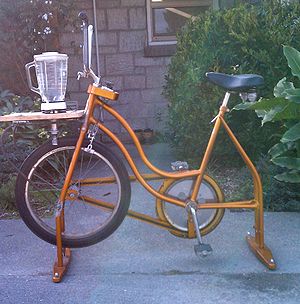
The Mechanical Munchy-Maker is a mechanical bicycle that turns human leg power into mechanical rotation and generates energy to power a kitchen appliance, such as a blender. It is designed to turn human leg power into mechanical rotation. As the user begins to pedal the stationary bike, the crank turns the front wheel using a chain drive. The front wheel is in contact with a spline-shaft that converts vertical circular motion into horizontal motion. The spline-shaft utilizes the friction produced by the contact of the spinning wheel with the spline-shaft to turn the blade on the blender. The design is capable of making various blended concoctions as desired.
Background[edit | edit source]
Samoa Hostel is located in Samoa, CA. The second floor of the hostel is planned to be renovated by the summer of 2011. It will be designed in a sustainable and historical manner. The objective of this project is to build a mechanical bicycle that teaches Samoa Hostel's visitors how to generate renewable energy. The design is meant to be located in the kitchen. Since the Samoa Hostels visitors will be bringing food, we decided to provide them with an ability to learn about sustainability while having fun and making a tasty form of food by pedaling.
The Mechanical Munchy-Maker is designed by Cal Poly Humboldt students enrolled in Engr205 class. The client for the Mechanical Munchy-Maker design project is the Samoa Hostel along with Danco Builders and the Humboldt Bay Center for Sustainable Living.
Criteria[edit | edit source]
In order to determine the best solution amongst alternative solutions, Samoa Solutions team has pursued with Delphi Decision Matrix. Criteria have been listed and each criterion has been weighted by team members individually, by scaling it from one to ten. One stood for the least important and ten for most important criteria that alternative solutions should meet. The team then agreed on a consensus for the criteria weight, which is presented in the Table 1.
The Table 1 presents the process of assigning the scores to the each criterion based on the individual assessment of criterion's importance for the final design. The scores were assigned by each member individually and the average value of individual scores is represented as the averages weight
| Table 1 presents assigned scores to th each criterion | ||
| Criteria | Description | Weight |
|---|---|---|
| Usability | The ease to use the design and to match the users needs and requierments | 10.0 |
| Safety | The absence of risks, injuries and accidents | 10.0 |
| Cost | The amount of money needed to purchase materials to build the bicycle, limited to 200$ for this project. | 9.0 |
| Durability | The ability to perform for more than two years | 9.0 |
| Maintenance Time | Time needed to keep the bicycle in a proper condition to perform | 8.0 |
| Multifunction | The ability to perform more than one function | 5.0 |
| Aestetics | Superficial appearance of the design | 5.0 |
Final Design[edit | edit source]
The Mechanical Munchy-Maker is constructed from a 1982 Schwinn Exercise Bike. The blender is attached to a base and connected to a friction drive. The friction drive is positioned on the top of the bicycle's flywheel and allows the blender to sit in front of the operator for ease of control as he or she is pedaling.
-
The electronic sketch-up of the Mechanical Munchy-Maker
-
Illustration of the connection between the friction drive and the flywheel
As more weight is added to the blender it will become more difficult to pedal giving the operator a good workout, along with a physical understanding for the amount of energy required to power such a mechanical deivce. The position of the friction drive on the flywheel allows for maximum friction between the two wheels. The spinning extension of the friction drive fits perfectly into the socket of the blender and spins the blades with accordance to the flywheel.
Costs[edit | edit source]
The implementation costs are a summation of the materials required to construct the solution. As listed in Table 2, we spent a total of $108.43 on the materials for our project. Also within Table 2 we included a column of potential costs that describes the prices one would expect to pay for the items we were able to get for free. The total of the potential costs is $516.43.
| Table 2 includes all materials and construction costs for Mechanical Munchy-Maker | ||
| Material | Our Cost ($) | Potential Cost ($) |
|---|---|---|
| Exercise Bike | 30.00 | 140.00 |
| Road Bike | 20.00 | 75.00 |
| Blender | 18.00 | 35.00 |
| 4' Rebar | 5.96 | 5.96 |
| Bike Hubs | 0.00 | 26.00 |
| 1' x 4' Board | 10.09 | 10.09 |
| Kitchen Aide | 0.00 | 200.00 |
| 3/8" Ratchet Extension | 10.48 | 10.48 |
| Rubber Grommets | 7.58 | 7.58 |
| Screws | 4.33 | 4.33 |
| Screws | 1.99 | 1.99 |
| Total Cost | 108.43 | 516.43 |
Testing Results[edit | edit source]
During testing, the friction drive showed a need to be tightly attached to the flywheel in order to provide maximal transfer of friction and force. The flexi glass protection added around the transmission mechanism increases the safety of by standers.
Discussion and the next step[edit | edit source]
The Mechanical Munchy-Maker uses a friction drive for power. The friction creates a lot of vibration and sound. There could be adjustments made to the flywheel and the part of the drive that touches the wheel, so that the drive fits into the flywheel similar to a cog.


